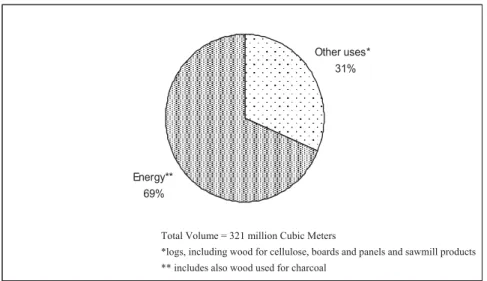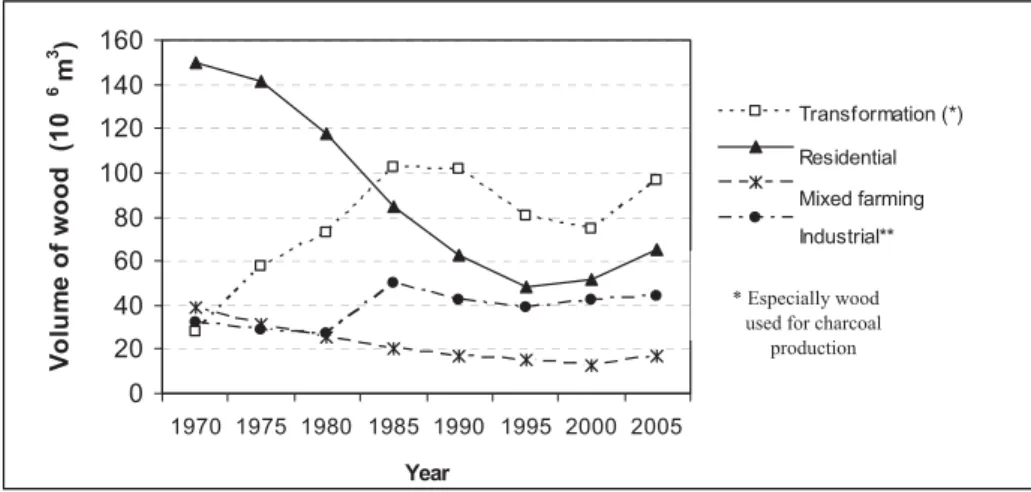The use of wood as energy
J
OSÉO
TÁVIOB
RITOIntroduction
T
he growth in world consumption of energy derived from fossil fuels has taken mankind into an energy matrix that is insecure, expensive and, above all, extremely bad for the environment. This has led many countries to consider the need for profound changes, including the intensification of use of other sources of energy, especially renewable energy, including wood.In the energy field, wood – traditionally in the form of firewood – has always made an historic contribution to the development of mankind, having been its first source of energy, initially employed for heating and the preparation of food. Over time, it came to be used as solid, liquid and gaseous fuel in various processes for generating thermal, mechanical and electrical energy.
Today, wood continues to take its place in the world’s energy matrix, to a greater or lesser extent, depending on the region. Its use is affected by variables such as: the level of development in a country, availability of forests, environmental questions and how it competes economically with other energy sources such as oil, natural gas, hydroelectricity, nuclear energy etc.
The use of wood for energy, in a worldwide context, is more evident in developing countries as illustrated in Figure 1. In such regions, it is a component of vital importance for the supply of primary energy, especially for domestic and industrial use. It is in the form of firewood that it makes up more than half the world’s total volume of wood consumed for all and any purposes.
Wood, in its simplest form as firewood or as its derivative charcoal, is a vital fuel for the preparation of food for an enormous number of families and communities in various parts of the planet. It is estimated that, for every six persons, two use wood as their main source of energy, particularly families in developing countries, who use wood to sustain processes such as drying, cooking, fermentation, the production of electricity etc. (FAO, 2003)
Figure 1 – Percentage of forest biomass in the national energy matrix of some countries (World Research Institute, 2007)
Quantitative aspects of using wood for energy in Brazil The use of wood for energy brings with it a lower dependence on foreign energy sources and greater security of supply, something that many fuels in current use do not provide. Furthermore, thanks to its high renewable and productive potential, especially in the case of Brazil, it can encourage an environmentally healthier and socially fairer energetic matrix since it is one of the energy sources with one of the greatest rates of job creation relative to investment.
Table 1 shows the position of wood in the context of the national energy matrix, according to the final consumption per source.
Table 1
Energy consumption in Brazil by source – Year 2005 (Ministério…, 2007a)
Sources
Millions of tons oil equivalent
(Mtoe)
%
Oil derivatives 83.68 42.71
Natural gas 13.41 6.84
Coal mineral (1) 4.85 2.48
Electricity 32.28 16.48
Wood (2) 22.37 11.42
Sugarcane by-products (3) 21.55 11.00
Other sources 17.77 9.07
1. Natural coal, coke and gas from coke; 2. Firewood and charcoal; 3. Ethanol and bagasse
Incomplete Data < 10
50 - 75
10 - 25
> 75
It is a relatively short time since wood ceased to be the main source of primary energy in our country, when, in the last century, or more exactly during the 1970s, it was overtaken by oil and, subsequently, by
hydroelectricity. The participation of wood in the Brazilian energetic balance has been decreasing over time, principally because there has been a greater incentive to use oil derivatives and hydroelectricity to supply the new demands for energy. In the last ten years, however, we can see a strong reversal of this tendency, as illustrated in Figures 2 and 3. This has possibly been motivated by uncertainties as to the supply from other sources and, above all, by the economic advantages and environmental and strategic opportunities offered by the use of wood as a source of energy.
Figure 2 – Evolution of wood consumption for energy in Brazil – 1970 to 2005 (Ministério…, 2007a)
Figure 3 – Evolution of consumption of wood for energy production in Brazil – 1995 to 2005 (Ministério…, 2007a)
150 170 190 210 230 250 270 290 310
1970 1975 1980 1985 1990 1995 2000 2005
Year Vo lu m e o f w o o d (1 0
6 m 3 )
y = 0,8921x2 - 5,815x + 180,97 R2 = 0,9632
165 175 185 195 205 215 225
1995 1996 1997 1998 1999 2000 2001 2002 2003 2004 2005
Year Vo lu m e o f w o o d (1 0
6 m3
The volume of wood currently consumed for energy is of the order of 220 million cubic meters per year, according to official sources linked to the energy sector (Ministério…, 2007a). Also according to government sources (Ministério…, 2007b) and institutions connected to the sectors of wood application in Brazil (Sociedade… 2007, Associação… 2007), its annual consumption as an industrial raw material reaches 142.7 million cubic meters, including the production of cellulose and paper, boards and panels and sawmill products. We can therefore conclude that 69% of the wood used in Brazil is destined for energy use, which, unarguably, represents the greatest volume of wood linked to a particular use in the country, as is illustrated in Figure 4.
Figure 4 – The destination of wood annually consumed in Brazil (Ministério… 2007a; 2007b; Sociedade…, 2007; Associação… 2007.)
Wood for energy production in our country has been historically linked to charcoal production and to residential, industrial and mixed farming agricultural use, as is shown in Figure 5 and Table 2.
The production of charcoal stands out within the overall consumption of wood as energy because of the existing demand for this product by the metallurgical sector. Brazil is the world’s largest producer of steel obtained through the use of charcoal as a means of reducing iron ore. It is an
established and expanding sector, responsible for hundreds of thousands of jobs, and a great deal of taxes and profits. Displaying a significant evolution in its response to demand through actions aimed at the sector’s sustainability, the use of charcoal from managed forests has shown a sharp growth. If, in 1990, it amounted to only 30% of the total volume consumed, it now already represents more than 70%. (Associação… 2004).
The second biggest consumer of wood for energy in Brazil is the residential sector. In this sector, wood is mainly used for cooking food and,
Other uses* 31%
Energy** 69%
TotalVolume = 321 million Cubic Meters
*logs, including wood for cellulose, boards and panels and sawmill products
on a smaller scale, for household heating. It is a consumption particularly linked to the growth of the domestic use of liquefied petroleum gas, its
natural substitute in the majority of Brazilian residences, and for which, unlike wood, official incentive policies have always been present. In spite of this fact, though, after a strong tendency for consumption to fall, over the last few years we can observe a return to the use of wood for energy production in the residential sector. The annual volume of wood used for this purpose is higher than the volume of wood used by sawmills in our country.
Figure 5 – Evolution of sectorial consumption of wood for energy in Brazil (Ministério… 2007a)
Table 2
Distribution of sectorial consumption of wood for energy in Brazil in 2005 (Ministério…, 2007a)
Sector %
Transformation (*) 43.3
Residential 29.0
Mixed farming 7.7
Industrial 19.8
Other 0.3
Total 100
* Mainly for the production of charcoal and, on a small scale, the generation of electricity
If we consider an average annual consumption of two cubic meters of wood per person, we can estimate that at least thirty million people are currently dependant on wood as a source of domestic energy in Brazil. Very probably, these are people from the poorer sections of the population, who – for economic or structural reasons – find it difficult to access other energy
0 20 40 60 80 100 120 140 160
1970 1975 1980 1985 1990 1995 2000 2005 Year
Vo
lu
m
e
o
f
w
o
o
d
(10
6 m 3 )
Transformation (*)
Residential
Mixed farming
Industrial**
* Especially wood
sources. In this context, we glimpse the existence of a powerful social
component with strong links to the food security question in the country that needs to be addressed by public policies.
The third most important use of wood for energy production in Brazil is spread over a series of components linked to the industrial sector, represented by thousands of industrial enterprises in areas such as cement, chemicals, food and drink, paper and cellulose and ceramics. The more prominent of these are the food and drink and the ceramics sectors, which together represent more than 60% of consumption (Ministério… 2007a).
The agricultural sector is the fourth largest consumer of wood for energy production in the country and, despite the lack of a precise analysis of the pattern of its consumption, it is believed to be concentrated in the drying of grain. We are, in any case, dealing with a considerable volume of wood, greater than that consumed by the production of boards and similar in the country.
The strategic role of the use of wood for energy production As has been observed, wood undeniably occupies a fundamental role in relation to strategies linked to the production and use of energy in Brazil, the return of its use for this purpose being evident in the last ten years. However, specific actions are still needed to support its more traditional energy uses, as in the production of charcoal, and domestic, industrial and agricultural uses. Added to this is the fact that there is still room for greater appreciation of its potential in the Brazilian energy landscape. This might include, for example, complementation of hydroelectric power generation by means of thermoelectric plants burning wood produced through the sustained management of forests; the use – in areas far from oil fields and refineries – of biodiesel produced from combustible vegetable oils extracted from forest plants; the use of gasification of wood or charcoal for the production of
industrial heat and for the powering of motors; and even the incentive of using firewood for cooking, in rural areas, through small reforestations and the use of more efficient cookers. There are, however, obstacles to be overcome – mainly in the institutional area – that are a consequence of the very nature of this form of energy.
energy, as in the case of wood, are basically operating within the private sector, mainly through small and medium sized enterprises more or less in isolation, and generally within a restricted area of action. In this way, these forms of energy do not develop an institutional framework of their own, from where planning and technological development may be readily promoted.
(Brito, 1990).
Another relevant point is the technological question. The experience of the charcoal-based Brazilian steel industry serves as an example that shows that renewable energy forms only become viable, on a large scale, if they develop from a primitive and rudimentary technological position based, simply, on the destruction of forests and progress to the incorporation of more advanced forestry technology in order to ensure greater efficiency and to become ecologically and economically compatible.
In a general way, the main cause of the destruction of forests is the establishment of an economic and industrial structure based on models developed for other national realities, which lead to an inadequate use of the physical and economical space. In this kind of structure, an artificial valuation of land takes place, and it comes to be seen as an investment that should therefore produce income. On account of this, and in most cases, the forest is cut down for different ends, while, not only to ensure possession, simulating productive exploitation of the land. It therefore becomes necessary to give an economic value to the forest in order to preserve it, and this can be done by the production of wood for energy production, as a continuous, planned, sustained and profitable activity maintaining a balanced relationship between the protection of the natural resource and the economic order.
The need for definitions and action related to the use of wood for the production of energy.
Wood is an essential component in answering Brazil’s demand for energy, all indications being that this will continue to predominate, with the major consumption coming from the production of domestic, industrial and agricultural charcoal. At the same time, there is still room for considering opportunities for other energy uses, still little attended to in terms of research, technological development and public policy. However, strategic actions have to be established, so that, at least, present conditions of use of this material can be maintained. In this context, the debate about the necessity for action that may make such a scenario more consistent is not new. In this sense, answering some of the points that have already been raised continues to be extremely relevant, such as (a) demystifying, removing from the sidelines, and giving value to the idea of the use of wood for energy; (b) improving the collecting and treatment of supply and consumption statistics; (c) incorporating
(e) managing native forests for energy purposes in a sustainable manner; (f) encouraging greater intensification in the use of forestry and industrial residues for energy ends; (g) encouraging and stimulating small and medium farmers in the mission of production and supply of wood for energy needs; (h) organizing and optimizing the “firewood industry”; (i) incorporating the procurement of wood for energy in the processes relating to the carbon market; (j) improving the efficiency of processes for energetic conversion of wood and broadening the application of the processes already in existence; (k) changing current technological charcoal production standards, including the bulk recovery of carbonization gases; (l) initiating studies, research and technological developments in the area of the application of wood for energy; (m) establishing extension and education programs relating to the use of wood for energy; and (n) defining policies for the use of wood for energy and effectively applying them in a coherent way, involving both the forestry and energetic sectors. (cf Brito, 1986, 1990, 1997, Brito & Deglise, 1991).
Bibliographical references
ASSOCIAÇÃO BRASILEIRA DE CELULOSE E PAPEL (Brazilian Cellulose and Paper Association). Available at <http:// www.ipef.br/estatisticas/relatorios/ Bracelpa-Relatorio_Estatistico_Florestal-2005.pdf> Consulted on January 30th
2007.
ASSOCIAÇÃO MINEIRA DE SILVICULTURA (Minas State Forestry
Association) Available at: <http://www.abracave.com.br/anuario.htm>. Consulted on March 18th 2004.
BRITO, J. O. Madeira para energia: a verdadeira realidade do uso de recursos florestais,Silvicultura, ed. Especial, n.41, p.188-93, 1986.
_______. Uma conjugação energético-ambiental para um mega-reflorestamento no Brasil.Estudos Avançados, v.4, n.9, p.268-70, May/August, 1990a.
_______. Tópicos atuais. Energia, economia, meio ambiente: as fontes renováveis de energia no Brasil. Revista Brasileira de Energia, v.l, n,3, 1990b.
_______. Fuelwood utilization in Brazil. Biomass and Bioenergy, v.12, n.1, p.69-74, 1997.
BRITO J. O.; DEGLISE. X. Status and Potential of Using Wood for Energy in Brazil.
Révue Forestiére Française, hors série n.6, p.175-9, 1991.
BRITO, S. S. Tópicos atuais. Energia, economia, meio-ambiente: as fontes renováveis de energia no Brasil. Revista Brasileira de Energia, V.l, n.3, 1990. FAO Wood Energy.
Promoting Sustainable Energy Systems. Forest Products Division. Rome, October, 2003.
MINISTÉRIO DO PLANEJAMENTO, ORÇAMENTO E GESTÃO. Instituto de Geografia e Estatística. Available at: <ftp://ftp.ibge.gov.br/Producao_Agricola/ Producao_da_Extracao_Vegetal_e_da_Silvicultura/2005/>.Consulted on January 30th 2007.
SOCIEDADE BRASILEIRA DE SILVICULTURA. Available at: <http://www. ipef.br/estatisticas/relatorios/SBS-2005.pdf>.Consulted on January 30th 2007.
WORLD RESEARCH INSTITUTE. Earth Trends. The Environmental Portal. Available at: <http://www.earthtrends.wri.org>. Consulted on January 30th 2007.
ABSTRACT – In the last ten years, an important restoration of wood consumption
for energy production purposes in Brazil has been taking place, going against a decline tendency initiated in the mid 1900s. For that reason, energy production still represents the greatest demand of wood for a determined application: 61% of the total volume. However, there is still a lot to conquer in the definition and implantation of pragmatic actions for the valorization of this practice in the country. In this paper, quantitative aspects of this application will be discussed, as well as its strategic scope and the request for the definition of actions and plans. Long-felt needs for the consolidation of this important and fundamental application of wood that haven’t been fulfilled are also pointed out, considering the current debate in which the use of fossil energy sources is being challenged.
KEYWORDS: Brazil, Wood for Energy Production, Quantitative and Strategic Aspects.
José Otávio Brito is full professor at the Luiz de Queiroz College of Agriculture (Esalq/US P), Piracicaba (SP). @ – jotbrito@esalq.usp.br
– This text has been translated by Brian Stirner. The original in Portuguese – “O uso energético da madeira” – is available at www.scielo.br/scielo.php?script=sci_ issuetoc&pid=0103-401420070001&lng=pt&nrm=iso



